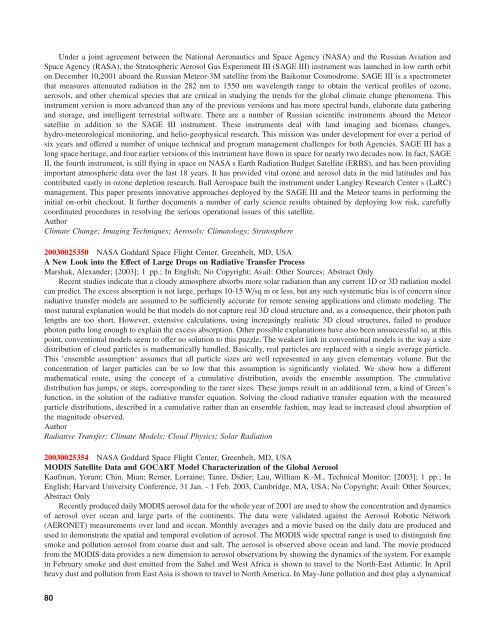You also want an ePaper? Increase the reach of your titles
YUMPU automatically turns print PDFs into web optimized ePapers that Google loves.
Under a joint agreement between the National Aeronautics and Space Agency (NASA) and the Russian Aviation and<br />
Space Agency (RASA), the Stratospheric Aerosol Gas Experiment III (SAGE III) instrument was launched in low earth orbit<br />
on December 10,2001 aboard the Russian Meteor-3M satellite from the Baikonur Cosmodrome. SAGE III is a spectrometer<br />
that measures attenuated radiation in the 282 nm to 1550 nm wavelength range to obtain the vertical pro<strong>file</strong>s of ozone,<br />
aerosols, and other chemical species that are critical in studying the trends for the global climate change phenomena. This<br />
instrument version is more advanced than any of the previous versions and has more spectral bands, elaborate data gathering<br />
and storage, and intelligent terrestrial software. There are a number of Russian scientific instruments aboard the Meteor<br />
satellite in addition to the SAGE III instrument. These instruments deal with land imaging and biomass changes,<br />
hydro-meteorological monitoring, and helio-geophysical research. This mission was under development for over a period of<br />
six years and offered a number of unique technical and program management challenges for both Agencies. SAGE III has a<br />
long space heritage, and four earlier versions of this instrument have flown in space for nearly two decades now. In fact, SAGE<br />
II, the fourth instrument, is still flying in space on NASA s Earth Radiation Budget Satellite (ERBS), and has been providing<br />
important atmospheric data over the last 18 years. It has provided vital ozone and aerosol data in the mid latitudes and has<br />
contributed vastly in ozone depletion research. Ball Aerospace built the instrument under Langley Research Center s (LaRC)<br />
management. This paper presents innovative approaches deployed by the SAGE III and the Meteor teams in performing the<br />
initial on-orbit checkout. It further documents a number of early science results obtained by deploying low risk, carefully<br />
coordinated procedures in resolving the serious operational issues of this satellite.<br />
Author<br />
Climate Change; Imaging Techniques; Aerosols; Climatology; Stratosphere<br />
20030025350 NASA Goddard Space Flight Center, Greenbelt, MD, USA<br />
A New Look into the Effect of Large Drops on Radiative Transfer Process<br />
Marshak, Alexander; [2003]; 1 pp.; In English; No Copyright; Avail: Other Sources; Abstract Only<br />
Recent studies indicate that a cloudy atmosphere absorbs more solar radiation than any current 1D or 3D radiation model<br />
can predict. The excess absorption is not large, perhaps 10-15 W/sq m or less, but any such systematic bias is of concern since<br />
radiative transfer models are assumed to be sufficiently accurate for remote sensing applications and climate modeling. The<br />
most natural explanation would be that models do not capture real 3D cloud structure and, as a consequence, their photon path<br />
lengths are too short. However, extensive calculations, using increasingly realistic 3D cloud structures, failed to produce<br />
photon paths long enough to explain the excess absorption. Other possible explanations have also been unsuccessful so, at this<br />
point, conventional models seem to offer no solution to this puzzle. The weakest link in conventional models is the way a size<br />
distribution of cloud particles is mathematically handled. Basically, real particles are replaced with a single average particle.<br />
This ’ensemble assumption‘ assumes that all particle sizes are well represented in any given elementary volume. But the<br />
concentration of larger particles can be so low that this assumption is significantly violated. We show how a different<br />
mathematical route, using the concept of a cumulative distribution, avoids the ensemble assumption. The cumulative<br />
distribution has jumps, or steps, corresponding to the rarer sizes. These jumps result in an additional term, a kind of Green’s<br />
function, in the solution of the radiative transfer equation. Solving the cloud radiative transfer equation with the measured<br />
particle distributions, described in a cumulative rather than an ensemble fashion, may lead to increased cloud absorption of<br />
the magnitude observed.<br />
Author<br />
Radiative Transfer; Climate Models; Cloud Physics; Solar Radiation<br />
20030025354 NASA Goddard Space Flight Center, Greenbelt, MD, USA<br />
MODIS Satellite Data and GOCART Model Characterization of the Global Aerosol<br />
Kaufman, Yoram; Chin, Mian; Remer, Lorraine; Tanre, Didier; Lau, William K.-M., Technical Monitor; [2003]; 1 pp.; In<br />
English; Harvard University Conference, 31 Jan. - 1 Feb. 2003, Cambridge, MA, USA; No Copyright; Avail: Other Sources;<br />
Abstract Only<br />
Recently produced daily MODIS aerosol data for the whole year of 2001 are used to show the concentration and dynamics<br />
of aerosol over ocean and large parts of the continents. The data were validated against the Aerosol Robotic Network<br />
(AERONET) measurements over land and ocean. Monthly averages and a movie based on the daily data are produced and<br />
used to demonstrate the spatial and temporal evolution of aerosol. The MODIS wide spectral range is used to distinguish fine<br />
smoke and pollution aerosol from coarse dust and salt. The aerosol is observed above ocean and land. The movie produced<br />
from the MODIS data provides a new dimension to aerosol observations by showing the dynamics of the system. For example<br />
in February smoke and dust emitted from the Sahel and West Africa is shown to travel to the North-East Atlantic. In April<br />
heavy dust and pollution from East Asia is shown to travel to North America. In May-June pollution and dust play a dynamical<br />
80
















